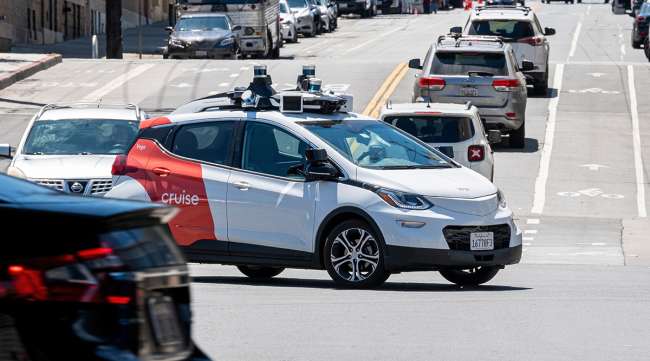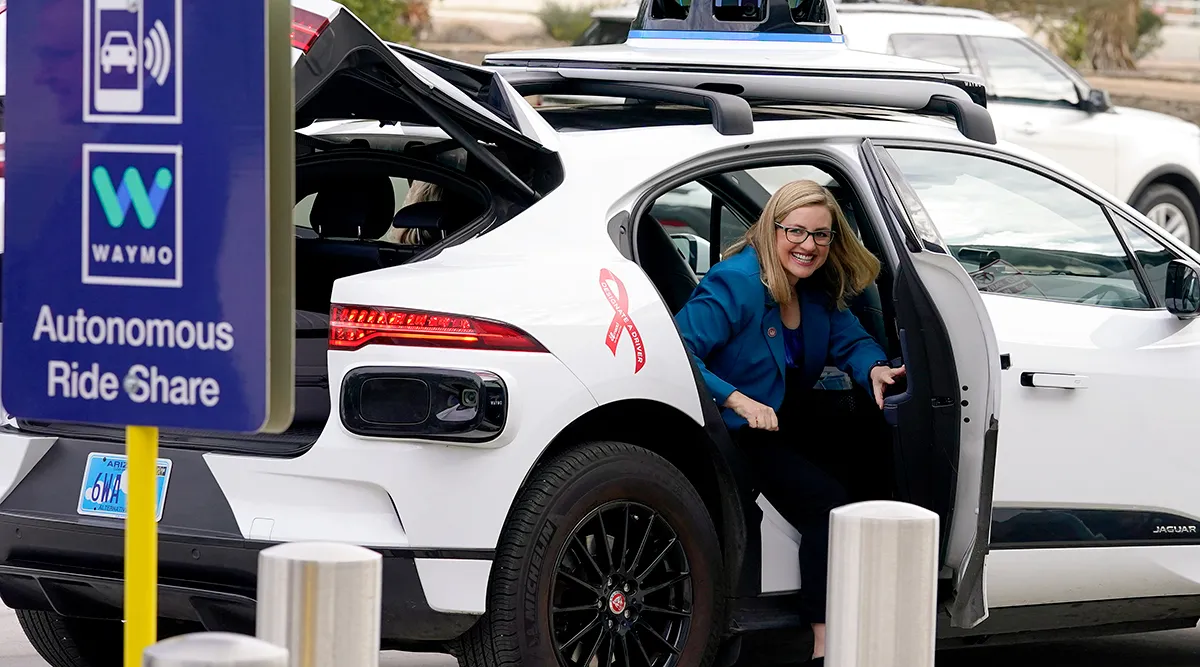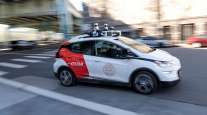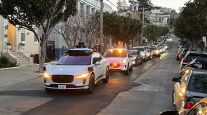Bloomberg News
Cruise, Waymo Cope With Robotaxi Backlash in San Francisco

[Stay on top of transportation news: Get TTNews in your inbox.]
Just before Patti Smith took the stage in San Francisco this month, the emcee thanked sponsors, including robotaxi company Waymo.
The audience booed, reflecting the hostility that’s growing in the city for one of tech’s most-watched industries.
There was the recent incident when a fleet of driverless vehicles froze and blocked traffic during a Friday night concert at North Beach. Days later, an autonomous car got stuck in wet cement at a construction site, and then a robotaxi crashed into a fire truck responding to an emergency call. Weeks earlier, pet lovers were mortified when a vehicle struck and killed a small dog.
The mishaps are adding to traffic and safety concerns over driverless vehicles, which zip around the city’s streets surrounded by sensors and cameras, collecting data and promising a world with fewer human interactions. The robotaxi backlash is intensifying as self-driving vehicles begin to gain real traction in San Francisco after years of development.
California’s regulator this month approved an expansion of robotaxi services in the city, allowing Waymo, a part of Alphabet Inc., and Cruise, a unit of General Motors Co., to begin charging fares for rides when the streets are busiest. But they’re also now battling labor unions, the city’s public transit system and city attorney David Chiu, who petitioned the state to suspend the expanded fare licenses.
If Chiu wins, it would be a setback for companies trying to monetize multibillion-dollar investments in self-driving cars. It could also signal to other companies developing the technology that the birthplace of autonomy is an increasingly difficult place for it to grow up.

Phoenix Mayor Kate Gallego arrives in a Waymo self-driving vehicle at the Sky Harbor International Airport Sky Train facility in Phoenix. (Matt York/Associated Press)
That’s putting California in a precarious position. High taxes and regulations have already sent some banking and tech companies heading east to places likes Texas. Autonomous tech companies are also branching out, with Cruise and Waymo expanding operations and test fleets in Sunbelt states with more permissive regulations and business-friendly governments. Cruise announced expansion plans for Raleigh, N.C., on Aug. 22.
“What isn’t getting harder in California?” said Christopher West, founder of L5AutoUSA, which promotes autonomous vehicles. “This is accelerating a natural progression to other cities and states.”
Cruise and Waymo are the only firms in California allowed to run paid robotaxi services around-the-clock. The approval came Aug. 10 from the California Public Utilities Commission, after Cruise worked for nine years to get 10 permits. Other states have been more lenient. Cruise secured a permit in Arizona in a month and Texas can offer them within days. In Florida, Georgia and North Carolina, the company said it doesn’t even require an autonomous vehicle permit.
While we continue our investigation in partnership with city officials and regulators, we wanted to provide an update on our preliminary analysis of the incident. Read more here https://t.co/yPPRIKwJ4W — cruise (@Cruise) August 19, 2023
As accidents grow along with the size of the fleets, self-driving cars are stirring up controversy in San Francisco.
Waymo has about 250 vehicles on the roads of the city, while Cruise had 400. After a spate of recent incidents circulating around social media, the California Department of Motor Vehicles ordered Cruise to cut its active fleet by half — a move supported by the Teamsters Union Local 250, representing public-sector drivers in the Bay Area. Cruise can now only operate 50 driverless cars during the day and 150 at night.
Rider demand already outpaces the supply of cars for hire in the city. Cruise and Waymo both say they have waiting lists to use their services. And as safety goes, neither company has reported a fatal crash in their cars, according to data collected by them and the National Highway Traffic Safety Administration.
San Francisco’s fire chief, Jeanine Nicholson, is one of the most outspoken critics of driverless vehicles — particularly taking issue with Cruise — and how they can hinder the work of emergency responders. With its famous hills, fog and narrow streets, San Francisco is a challenging city for fire trucks to maneuver in. During an emergency, response times — by seconds and minutes — really matter, especially when it comes to saving lives.
“Every time something happens with a Cruise vehicle, they come out with their PR folks and take zero responsibility,” Nicholson said by phone. “We need them to come to the table and admit there are challenges and issues, and work with us to solve them.”
The Waymo Driver adjusts to dynamic situations like construction, road closures, and traffic to get riders where they’re going safely and efficiently everyday. pic.twitter.com/M07qqYIHEX — Waymo (@Waymo) August 17, 2023
Cruise has invited Nicholson for discussions on multiple occasions over the past few months without success, according to a spokesperson. The company said it also has reached out to the San Francisco Fire Department’s leadership about 30 times in the past four months to continue dialogue. The department says it has pushed for incident review meetings and wants its operational staff to meet with engineers.
In an emailed statement, Waymo said it’s committed to bolstering road safety and building community trust.
“We maintain great respect for our first responders and appreciate our ongoing relationship with them,” the company said.
In the city’s attorney petition, Chiu said the fire department reported about 60 cases of driverless cars interfering with its work since April 2022. He gave examples of Waymo and Cruise cars causing problems, including an incident on Aug. 5 when a Waymo car entered an active firefighting scene, obstructing firefighters as they were trying to extinguish a burning car.

Ryan Manthir of Shell Global Solutions and Michael Grahe of Navistar discuss the future of the internal combustion engine. Tune in above or by going to RoadSigns.ttnews.com.
The city isn’t only concerned about safety, but also losing transit riders and fare revenue to driverless cars. The San Francisco Municipal Transportation Agency has resisted giving permits to competitors like Cruise and Waymo, while blaming Uber Technologies and Lyft Inc. for adding to traffic congestion and pollution.
There are groups that see the benefits of driverless cars, especially for people with disabilities and for workers who need extra transport options. The Service Employees International Union, National Federation of the Blind and International Brotherhood of Electrical Workers Local 6 are among the organizations that have supported an expansion of autonomous vehicles.
“There are cities around the country that will gladly welcome the technology and what it means for their economy,” said Grayson Brulte, a government affairs consultant. “Arizona, Florida and Texas will be beneficiaries in the same way that they are beneficiaries of financial migration.”
— With assistance from Karen Breslau.
Want more news? Listen to today's daily briefing below or go here for more info:




